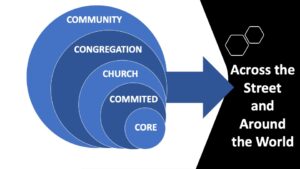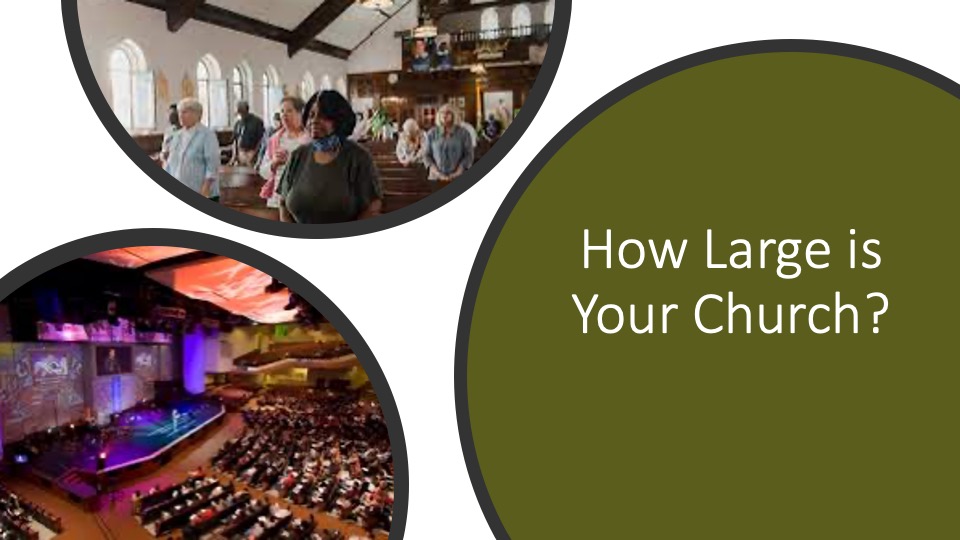How large is your church? If you are like most people, you define the size of your church by the number of weekly attenders. Maybe active members. Or perhaps total membership. About thirty years ago, I read a book by Kennon Callahan, a well-known consultant at the time. In The Twelve Keys to an Effective Church, Callahan contends that your church is probably larger than you think.
In the work of church revitalization it is incredibly important to know the actual size of your church. Many times declining or dying congregations take on a woe-is-me mindset, which only exacerbates the decline. A down-in-the-dumps mindset is counter productive to turnaround.
About a year ago, a colleague asked me this question concerning Huffman Baptist Church, where I serve as lead pastor: “What excites you about this place?” Huffman Baptist is a legacy church that once stood as one of the largest and strongest Southern Baptist churches in the Birmingham, AL metro area. At the time he asked me the question, she was but a Shadow of Her Former Glory. It was a Monday morning after one of those cold and dreary January Sundays. Attendance had been abysmal. There was a resurgence of Covid. The HVAC system wasn’t working. You get the picture. So, his question was warranted.
My answer was simple: “The potential.” I maintain that most churches in America are larger than they think. If not in actual size. In their potential for making disciples. In his monumental work, The Purpose Driven Church, Rick Warren identified five “circles of commitment” that exist in every congregation. The circles are concentric, which means the population of each group is contained in each of the groups that is larger (see illustration below).
A New Model

I propose a new model for considering the size of your congregation that captures your potential for making disciples. I have modified Rick Warren’s concentric circle model and applied the principles of Kennon Callahan’s theory to create a model that brings hope and direction for declining churches. In this model, I change some of the labels. More importantly, I define each circle as a constituency for making disciples.
The Core
The Core includes your key leadership. In terms of commitment, these are those who have given evidence of their commitment to the values and vision of the church. This includes staff members, elders, deacons, committee members, small group leaders, as well as others who are actively serving in leadership roles. In a healthy church, these leaders are also those who are disciples who are making disciples.
In my recent “State of the Church” message, I applied this model to our current situation. It was an eye-opening experience. For the sake of illustration, I will share that information here and in the explanations of the other constituencies. As this group grows larger and stronger, so does the family of faith. At Huffman, The Core includes about 50 members who are either serving in leadership or have served in the past two years.
The Committed
The Committed includes members who are engaged with the vision and values of the church. While they may be at varying levels of growth in their discipleship, they are with you. They attend, They serve. They give. In most situations, this is the group we consider when asked, “How big is your church?”
In making the application for our situation, I considered everyone who attended at least 50% of the Sundays as well as everyone who financially supported the church over the previous twelve months. This allowed us to include homebound members who are still committed to the vision and values of the church as evidenced by their financial support, even if they can not attend. At Huffman, The Committed includes 150 members. Of course, this includes the 50 at The Core.
The Church
This is the group that Rick Warren labeled as The Congregation. As you will see, I apply that label to my next constituency. The Church includes the committed and the uncommitted. The engaged and the disengaged. These are the people for whom I believe God holds us accountable to shepherd (See Hebrews 13:17). At some point in their lives, they believed that God was placing them in the local body according to his design (See 1 Corinthians 12).
In addition to the 150 members who are engaged with our vision and values (The Committed & The Core), The Church includes an additional 75 disengaged members. We only include those whom we can identify in this group. We know where they live, and we know how to contact them. Our responsibility is to shepherd them toward the heart of God, whether that means they engage with our vision and values, or with those of another church. In the words of Thom Rainer, “An inactive church member is an oxymoron” At least I think he’s the one who said it.
The Congregation
This is the group which Rick Warren identified as the crowd. I prefer The Congregation because it includes some church members who are disengaged. In other words, they are not part of the crowd. The additional constituents who make up this group includes those who gather with us, who grow with us, and who go with us, but who have not yet identified with us in church membership. These are regular attenders. Some of them long-time attenders. They are adults. And students. As well as children and preschoolers.
At Huffman, the size of The Congregation includes an additional 50 souls who are engaged with our vision and values but who have not yet become a part of The Church. If you are keeping score, The Congregation includes 275 people, which brings us to the last of the five concentric circles.
The Community
Rick Warren defines The Community as everyone your church has the opportunity to reach including those you do not know. For my purposes, The Community includes the total church family as well as those who are served by the ministries of the church.
Consider the possibilities. Families served through your Child Development Center. How about families involved in recreation ministries. People served through your food pantry or other needs-based ministries.
At Huffman, these additional constituents include people and families we serve through ministry partners with whom we collaborate on our campus. We believe that God has brought these additional souls onto our campus for a purpose. In addition to the purpose of each ministry partner, we believe God has commissioned us to make disciples across our entire Community of members, regular attenders, as well as those we and our partners serve on our campus for the sake of the gospel.
Conclusion
If I gave the standard response to the question, “How big is your church?”, I would say, “About a hundred.” That’s because at this moment, that is the average number of people I see on a Sunday morning. But the truth is that Huffman Baptist Church is responsible for more than 450 souls whom God has entrusted to us.
In future article, I’ll post the implications of this model for church staffing and budgeting, as well as ministry strategy. We will also take a look at those to whom the entire community is sent to make Jesus known. Those who live across the street and around the world.
In the mean time just remember. Your church is probably larger than you think!
_________________________
Rob Paul is a church revitalization strategist with over three and a half decades of experience serving established churches in pastoral ministry. He has helped churches in Alabama, Mississippi and Georgia to experience revival and revitalization by God’s grace and for His glory. He is currently serving as the senior pastor of Huffman Baptist Church in Birmingham, AL. To find out more about Rob Paul Ministries and the work of church revitalization, visit Church Revitalization Resources.

